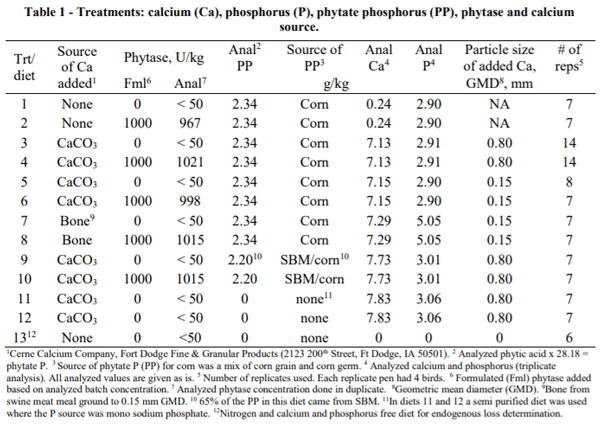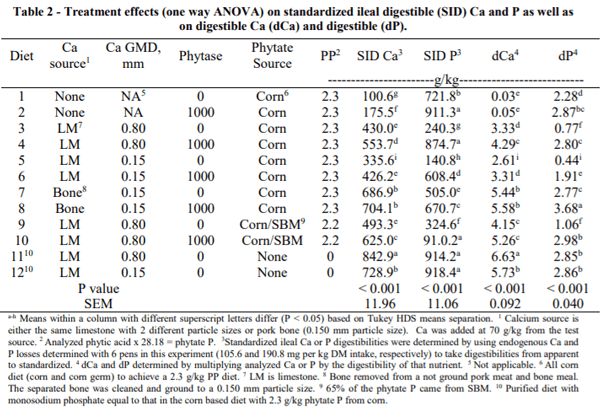I. INTRODUCTION
As we learn more about the negative impacts of calcium (Ca) on the availability of phosphorus (P) in broiler diets, it highlights how little we know about Ca requirements, digestibility of Ca in ingredients and optimal Ca to P ratios. The interactions through which Ca exerts some of its negative effects can be direct or through chelation’s with phytate and the latter having a profound impact on the efficacy of phytase and on P digestibility. Historically the ratio of Ca to P has been defined as total Ca to total P or total Ca to available P in the diet. Currently we have measures of “availability” of P in ingredients (available, digestible and retainable P) but we continue to use total Ca to formulate poultry diets and to define Ca requirements. Our inability to define ingredient Ca digestibilities, provide accurate estimates of digestible Ca matrix values for phytases, and importantly corroborate digestible Ca needs of the animal hinder us in being able to formulate and use both Ca and P effectively. For the animal, what is important are the amounts of Ca and P that can be digested, absorbed and potentially used for deposition in body tissues as well as for metabolic needs. Retainabilities of Ca and P are directly and quickly impacted by digestible Ca (dCa) and P (dP) ratios. At requirements dCa and dP values are very close to retainable values (Jimenez Moreno et al., 2013). In order to fully implement a system that allows us to feed closer to P requirements and reduce P excretions, we need to understand the digestibility of Ca in ingredients and factors that affect these and ultimately, work towards a dCa to dP system. A general review of this literature was published in 2017 (Li et al., 2017).
Several papers have been published in recent years on methods as well as ingredient Ca digestibilities (Anwar et al., 2015, 2016 a, b, c; Anwar, 2017; Proszkowiec-Weglarz et al., 2013 a, b). Data from Anwar (2017) shows that as particle size decreases from a 1 to 2mm limestone to <0.5mm limestone, true Ca digestibility decrease from 62 to 38%. Similar results were found in work done at the University of Maryland (Angel, 2018) where Ca digestibility decreased as particle size of the limestone decreased.
The goal would be to define a range of optimal dCa to dP ratios for diet formulation that require that dCa and dP needs of the broiler and ingredient SID Ca and P be defined. A better understanding is needed of the impact of other factors that affect the ability of the animal to digest and/or absorb Ca and P, such as the physical form and type of concentrated Ca containing ingredients such as limestone and their solubility; use and concentration of phytase, phytate source and concentration, inclusion and concentrations of vitamin D or its metabolites as well as other feed additives, age, and diet ingredient selection to name just a few. Because we still do not understand the role that specific phytate or Ca sources or phytate concentration play in the interactions that occurs between Ca, P, phytate and phytase, the work that will be discussed was done to develop a better understanding of these interactions in order to start building towards a dCa to dP formulation system.
II. METHOD AND DISCUSSION
The objective of this work was to determine the impact of: 1. Presence or absence of phytate on SID Ca; 2. Source of calcium on SID Ca and P; 3. Source of phytate on SID Ca and P using one source of Ca; 4. Particle size of limestone.
A digestibility methodology developed at the University of Maryland (Angel, 2013 and 2017; Angel et al., 2013, 2014, 16; Proszkowiec-Weglarz et al., 2013 a and b) was utilized in this work. This method was chosen because it allows for the determination of Ca and P digestibilities concurrently. It was felt that because of the close and high impact interactions that occur between Ca and phytate, it was necessary to do the work in the presence of phytate as well as in the presence or absence of phytase. Despite publications talking about phytate free nutrition (reviewed by Cowieson et al., 2016) what is often disregarded is that today there is no evidence that all the phytate can be removed quickly enough in the proventriculus and gizzard such that all potential chelation’s (with mineral cations and soluble proteins) can be avoided 100%. In this study either 0 or 1000 U/kg of a commercial Buttiauxella spp. phytase expressed in Trichoderma reesei was used.
All animal work was approved by the Institutional Animal Care and Use Committee of University of Maryland. One-day old Ross 708 male broiler chicks were obtained from a local commercial hatchery. Broilers were fed a commercial prestarter (hatch to 7 days) and starter diets (8 d to 20 d of age) and then fed the experimental diets for 36 h.
Thirteen treatments (diets) were tested (Table 1). Three basal diets were mixed plus a nitrogen/Ca/and P free diet in order to manufacture the 13 experimental diets. All basals contained a micro mineral and vitamin premix as well as salt, sodium bicarbonate, choline chloride, soy oil and an indigestible marker (premix of TiO2 and corn added at 20 g/kg to the basal to achieve a 5.8 g/kg Ti concentration in the final diet). Basal 1 contained corn and corn germ in proportions to yield 2.3 g/kg PP (2.34 g/ kg PP by analysis). This basal made up 956.7 g/kg of the final experimental treatments (1 through 8). For diets 1 and 2 containing no added limestone, ground silica (celite) was used as the filler to achieve 100%. It was then mixed, subdivided into 2 equal parts and phytase added from an analyzed batch to obtain 1000 U/kg. Limestone from 1 batch that was ground to achieve either 0.8 (diets 3 and 4) or 0.15 (diets 5 and 6) mm geometric mean diameter (GMD) was added to achieve 70 g/kg Ca in the final diet with only 2.4% Ca coming from the basal. Diets 7 and 8 contained bone meal, ground to a 0.152 mm GMD, added to the basal to achieve 70 g/kg Ca from bone meal in the final diet. Basal 2 contained SBM and corn, mixed to yield a 2.3 g/kg PP diet with 65% of the PP coming from SBM and 35% from corn. The same procedure as describe previously was used to make the 0 and 1000 U phytase/kg diets (9 and 10). The nitrogen/Ca/P free (NF diet) diet was mixed in one batch and subdivided into 3 parts. It was used as the basis for 3 treatments: for treatment 13, the basal diet was fed as mixed to determine endogenous losses; and for treatments 11 and 12, the same limestone of 0.8 and 0.15 mm was added to the NF diet. These last 2 diets also contained mono sodium phosphate to achieve in similar P concentration as the phytate containing diets.

The experimental diets were fed to battery pens of 4 birds for 36 h between day 20 and 22 of age. All birds within a pen were sampled for distal ileal digesta collection. The birds were first anesthetized with a gas mixture of 35% CO2, 35% N2, and 30% O2 (2 to 3 min) and then killed with CO2 (2 to 3 min). The content in the distal ileum, the distal half from Meckel’s diverticulum to 3 cm above the ileo-cecal junction, were collected
Dry matter in all samples was determined by drying overnight in a 100°C oven. Ingredients, feed and ileal samples were analyzed for Ca and P after acid digestion using inductively coupled plasma atomic emission spectrometry (ICP-AES; AOAC, 1999). Phytate-P in the basal diet was analyzed based on the method of Vinjamoori et al. (2004). Titanium dioxide concentrations in diets and ileal content were determined as described by Short et al. (1996). Phytase in diets was determined with an assay based on that of Engelen et al. (2001). Particle size and distribution were determined in all ingredients using the ASAE method S319.4, 2008.
Data were analyzed by the GLM procedure of JMP 12 (SAS Institute, 2015). Trt were considered as a fixed effect and pen within a block as a random effect. Tukey’s (Tukey, 1949) adjustment was applied in all pair-wise comparisons to protect P-values. Pen within a block was the experimental unit and all calculations were generated based on pen averages. Significance was declared at P < 0.05. Specific contrasts were done to determine main effects and interactions.
III. RESULTS AND DISCUSSION
SID Ca and P for all Trt are presented in Table 2. Results of specific contrasts are discussed but not included in tables.
This experiment was designed to answer several questions. Results of digestibility will be presented based on the main questions posed.
a) Does phytate source affect digestibility of Ca and P in the presence or absence of phytase and a limestone from one source? There was a main effect (P < 0.01) of phytate source and phytase on SID Ca but no (P>0.05) interaction. Limestone Ca digestibility was higher in diets containing phytate originating from SBM (1.5 g/kg)/corn (0.8 g/kg) vs that in diets with phytate only from corn (main effect means 559.2 and 491.8 g/kg, respectively). This suggests that the chelation of reactive Ca (ionized, soluble Ca) is greater with phytate from corn as compared to that of SBM. Phytase inclusion at 1000 U/kg increased SID Ca from 461.6 to 589.4 g/kg with no phytate source x phytase interaction seen. This points to an improvement in SID Ca with phytase addition being similar regardless of phytate source. There were main and interaction effects (P < 0.01) of phytate source and phytase on SID P. In the absence of phytase, SID P was greater when the diet contained 1.5 g/kg of its PP (2.3 g/kg) from SBM as compared to that when the diet contained all PP from corn. There was a greater improvement in the SID P in the presence of phytase when dietary phytate originated from both SBM and corn vs phytate originating only from corn (910.2 and 874.7 g/kg, respectively). This suggests that the effects of phytate on SID P, and similarly, the magnitude of the phytase effect on SID P, are dependent on the source of phytate in the diet. It will be important in the future, to evaluate the effect of more phytate sources on Ca digestibility from limestones and on the impact of phytase source and level.
b) Does Ca source added to a diet with a defined source and concentration of phytate, affect digestibility of Ca and P in the presence or absence of phytase? There were main and interaction effects (P < 0.01) of Ca source (limestone or bone) and phytase on both SID Ca and P. Irrespective of phytase inclusion, SID Ca was greater (P < 0.01) when Ca originated from bone vs limestone. However, phytase only increased the SID Ca when Ca originated from limestone, but had no effect on SID Ca when the Ca originated from bone. These data suggest an important and large difference in the response in SID Ca from phytase that is dependent on Ca source and is potentially related to the reactivity (solubility at pH at or below 3) of the Ca in the different Ca source. It is important to note that even though PP concentration was the same in these diets, total P was much higher in the diet containing bone (5.05 g/kg) vs that containing limestone (2.91 g/kg) and this may have a confounding effect. The source of Ca also affected the magnitude of response in SID P from phytase with a substantially smaller improvement in SID P of 165.7 g/kg from phytase when the dietary Ca originated from bone meal vs. an improvement in SID P of 467.6 g/kg when the sole Ca source was from limestone. P concentration in the diet can affect P digestibility (Sommerfeld., et al 2018). The Ca-source dependent differences in the improvement in the SID Ca and P following phytase addition would suggest that phytase matrix values may be dependent on the source of dietary Ca and are substantially smaller when the Ca originates from bone vs. limestone.
c) Is the effect of Ca particle size on digestibility of Ca and P similar when diets contain phytate from a defined source, or no phytate? A reduction in limestone particle size reduced (P < 0.01) SID Ca in both diets containing 2.3 phytate from corn, as well as in phytate free diets. There was no interaction of limestone particle size and presence of PP on SID Ca. When the phytate free diets were used SID Ca for limestone was higher (P < 0.01) as compared to SID Ca of the same level and source of limestone when this was added to diets containing 2.3 g/kg PP from corn (main effect means of 785.9 vs 382.8 g/kg, respectively).In contrast to results on SID Ca, there was an interaction (P < 0.01) of Ca particle size and PP concentration on SID P. A reduction in limestone particle size from 0.8 mm to 0.151 mm reduced SID P from 240.3 to 140.8 g/kg, but had no effect on SID P in diets without phytate (914.1 vs 918.4 g/kg, respectively).
d) What is the effect of limestone particle size? SID Ca was affected (P < 0.01 by particle size and phytase but no interaction effect was seen. A reduction in particle size of a limestone from the same batch from 0.80 or 0.15 mm GMD decreased SID Ca from 491.8 to 380.9 g/kg (P < 0.01, main effect means) while phytase addition at 1000 FTU increased the SID Ca from 382.8 to 490.0 g/kg. Although the improvement in SID Ca from phytase was numerically greater when diets contained the 0.8 mm limestone (123.7 g/kg) vs the 0.151 mm GMD (90.6 g/kg), there was no interaction of limestone particle size and phytase addition (P = 0.1189). In contrast, there was an interaction (P < 0.01) of limestone particle size and phytase on SID P, with a substantially greater improvement in SID P when phytase was added (634.4 g/kg) in diets containing the 0.8 mm GMD limestone vs 467.6 g/kg when the 0.151 mm GMD limestone was included. This shows that the magnitude of the phytase response on SID P was affected by limestone particle size. A reduction in the limestone particle size from 0.8 mm to 0.151 mm GMD reduced SID P to a greater extent when diets contained phytase than in the absence of phytase.

ACKNOWLEDGEMENTS: This work was, in part, supported by Cargill Animal Nutrition and DuPont Industrial Biosciences / Danisco Animal Nutrition.
Abstract presented at the 30th Annual Australian Poultry Science Symposium 2019. For information on the latest edition and future events, check out https://www.apss2021.com.au/. 











.jpg&w=3840&q=75)